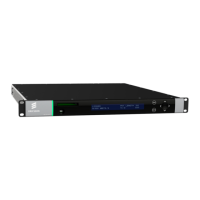Using the Equipment
Figure 3.108 Video Standards Fields
• Video 625 Standard – This sets the required standard for the composite output
when a 625 line source is output from the unit. A 625 line standard is assumed
when a 25Hz or 50Hz input standard is detected, this includes HD standards
which will be down converted and output as a 625 standard composite video
picture.
The RX8000 allows the user to select the following regional output standards:
- PAL BDGHI – This set of standards are the most commonly used PAL
standards throughout the world.
- PAL N – This is primarily used in Paraguay and Uruguay, it is similar to
other PAL standards but has a different chrominance subcarrier.
- PAL N CMB – This is primarily used in Argentina. This is similar to other
PAL standards but has a different burst frequency and has a different video
bandwidth.
- SECAM: This variant is for the Russian market only and is only supported by
the RX8330 with the RX8300/HWO/RSECAM option.
• Video 525 Standard – This sets the required standard for the composite output
when a 525 line source is output form the unit. A 525 line standard is assumed
when a 30 Hz, 29.97 Hz, 60 Hz or 59.94 Hz input standard is detected, this
includes HD standards which will be down converted and output as a 525
standard composite video picture.
The RX8000 allows the user to select the following regional output standards:
- NTSC M – This standard is the most commonly used NTSC standards
throughout the world.
- PAL M – This is mostly used in Brazil. This is a 525 line / 30Hz version of
the PAL system.
- NTSC J – This is primarily used in Japan. This is similar NTSC but has
some differences with its black and blanking levels.
• Default Output Standard – This sets the output standard for default when the
RX8000 first boots up. If no video is detected after boot up, the unit will produce
the appropriate Fail Mode screen (or Test Pattern mode if not set to NONE)

